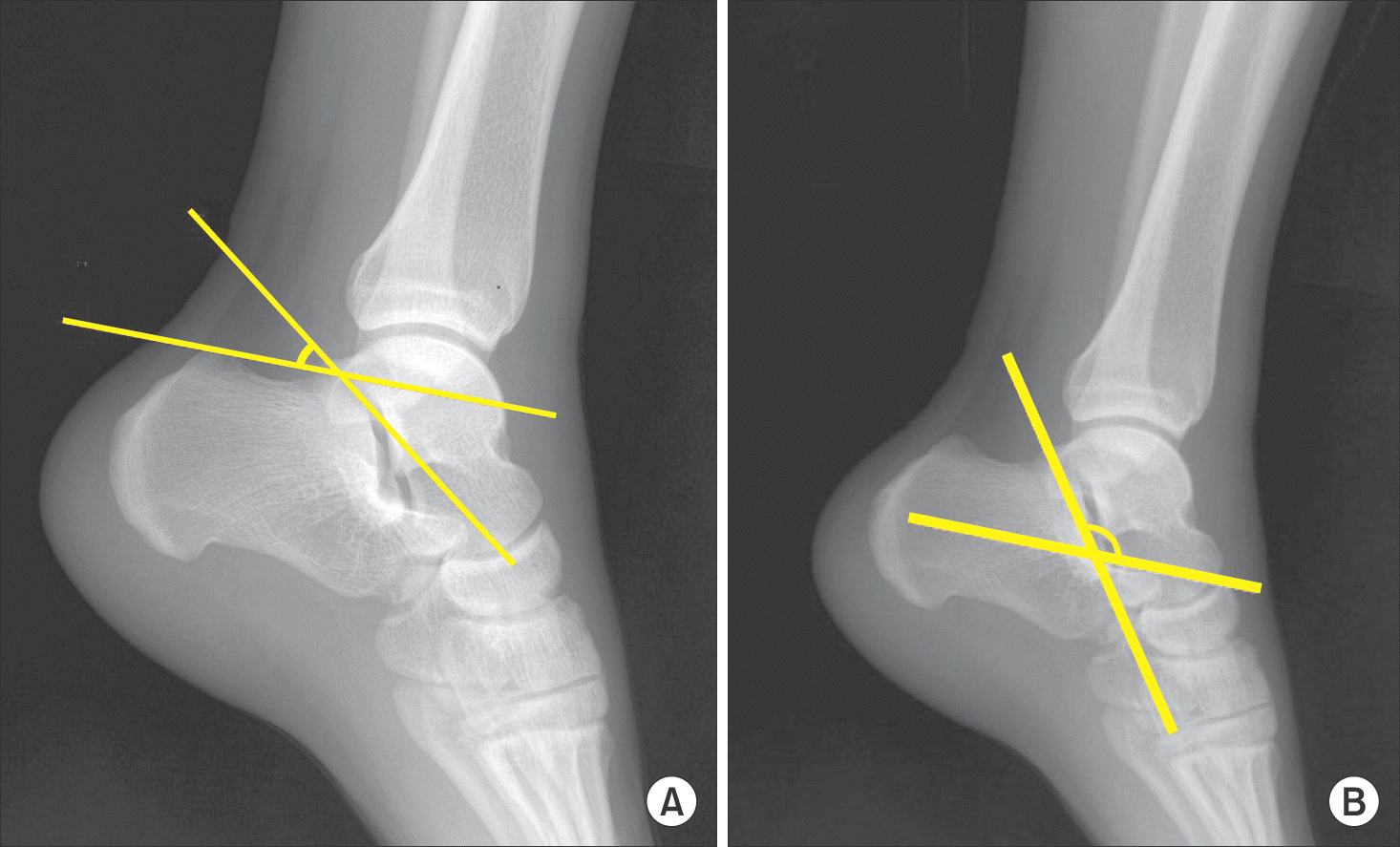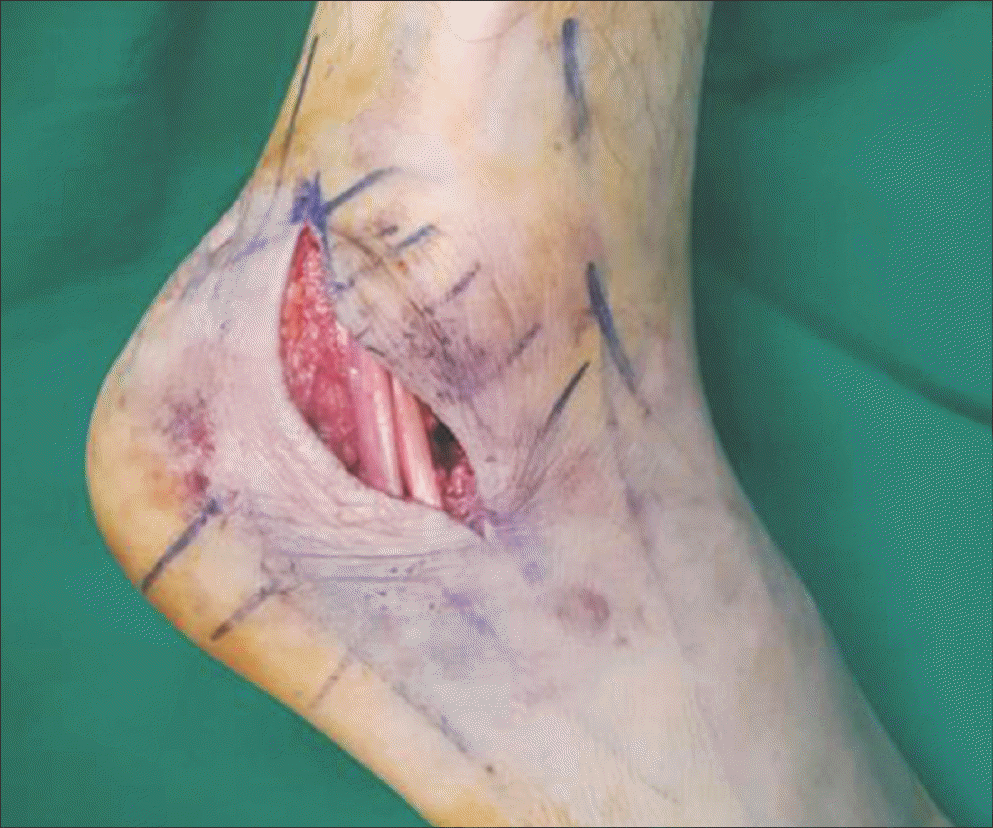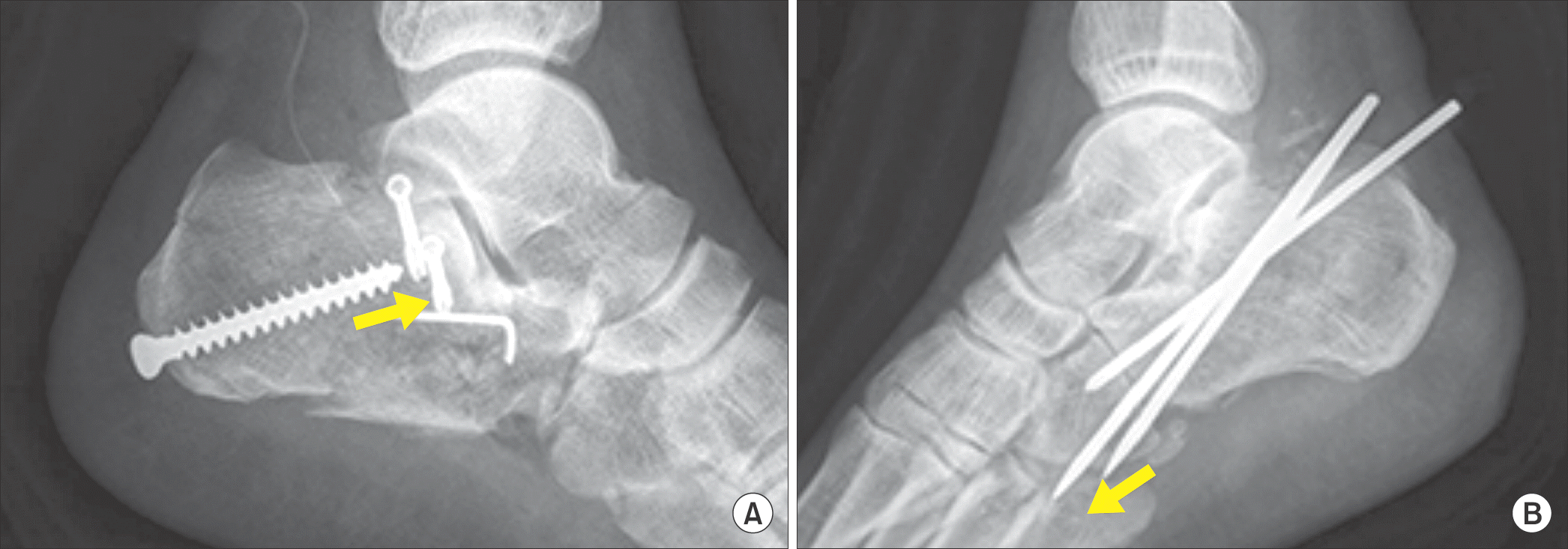Abstract
Purpose:
Materials and Methods:
Results:
REFERENCES
 | Figure 1.Measurement of Bohler and Gissane angles. (A) Bohler angle is measured by the intersection of a line drawn from most cephalic point on tuberosity to highest point of posterior facet with a line from highest point of posterior facet to most cephalic part of posterior process of calcaneus. (B) Gissane angle is measured by the intersection of a line drawn from the highest point of the posterior articular facet to the highest point of the posterior tuberosity and a line from the former to the highest point on the anterior articular facet. |
 | Figure 2.Beginning from 2.5 cm superior to lateral malleolus tip, which is the midpoint between malleolus and Achilles tendon, the incision continues obliquely and distally toward 1 cm below the lateral malleolus tip, sinus tarsi, and dorsolateral aspect of the talonavicular joint. |
 | Figure 3.Operative method. (A) A 6.5 mm cancellous buttress screw should be inserted from posteroinferior aspect of calcaneal tuberosity to the posterior facet (arrow). (B) Steinmann pins should be inserted from posterosuperior aspect of calcaneal tuberosity to the calcaneocuboid joint (arrow). |
Table 1.
| Variable | Group A | Group B | p-value |
|---|---|---|---|
| Number of patients | 32 | 18 | |
| Mean age (yr) | 44.5 (21∼63) | 43.5 (24∼61) | 0.593 |
| Gender (male) | 22 | 10 | 0.869 |
| Affected foot (right) | 14 | 9 | 0.612 |
| Smoker | 10 | 4 | 0.245 |
Values are presented as number or mean (range). Group A: a 6.5 mm cancellous full threaded screw inserted from the posteroinferior aspect of the calcaneal tuberosity to the posterior facet Group B: Steinman pin inserted from the posterosuperior aspect of the calcaneal tuberosity to the calcaneocuboidal joint.
Table 2.
| Angle | Preoperative | Postoperative | Final follow-up | p-value* | p-value† |
|---|---|---|---|---|---|
| Bohler angle | 10.1°±4.4° | 27.2°±2.2° | 26.6°±2.5° | 0.009 | 0.845 |
| Gissane angle | 126.2°±5.5° | 117.1°±3.2° | 118.6°±4.4° | 0.011 | 0.385 |
Table 3.
| Angle | Preoperative | Postoperative | Final follow-up | p-value* | p-value† |
|---|---|---|---|---|---|
| Bohler angle | 5.0°±3.4° | 29.9°±3.1° | 26.9°±3.0° | 0.001 | 0.557 |
| Gissane angle | 129.8°±9.5° | 119.3°±8.7° | 120.2°±12.0° | 0.004 | 0.985 |
Table 4.
Values are presented as mean±standard deviation. Group A: a 6.5 mm cancellous full threaded screw inserted from the posteroinferior aspect of the calcaneal tuberosity to the posterior facet; Group B Steinman pin inserted from the posterosuperior aspect of the calcaneal tuberosity to the calcaneocuboidal joint.
Table 5.
Values are presented as mean±standard deviation. Group A: a 6.5 mm cancellous full threaded screw inserted from the posteroinferior aspect of the calcaneal tuberosity to the posterior facet; Group B Steinman pin inserted from the posterosuperior aspect of the calcaneal tuberosity to the calcaneocuboidal joint.
Table 6.
| Type | Group A (n=32) | Group B (n=18) | p-value |
|---|---|---|---|
| Type II (n=28) | 82.5±4.6 | 82.7±5.8 | 0.960 |
| Type III (n=22) | 76.2±3.7 | 79.3±4.2 | 0.796 |
Values are presented as mean±standard deviation. Group A: a 6.5 mm cancellous full threaded screw inserted from the posteroinferior aspect of the calcaneal tuberosity to the posterior facet; Group B: Steinman pin inserted from the posterosuperior aspect of the calcaneal tuberosity to the calcaneocuboidal joint. AOFAS: American Orthopaedic Foot and Ankle Society.




 PDF
PDF ePub
ePub Citation
Citation Print
Print


 XML Download
XML Download